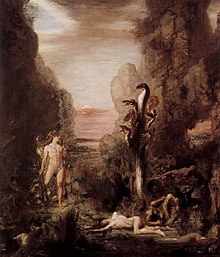Hydra (mythology)


Hydra ( ancient Greek Ὕδρα ) is a many-headed monster in Greek mythology . If she loses a head, two new ones grow, and the head in the middle is immortal. Your breath is said to be fatal. The hydra is also referred to as a water snake , from which its name is derived: ὕδρα hýdra means "water snake, water animal" (to ὕδωρ hýdōr " water ").
Hydra is considered the daughter of Echidna and Typhon as well as the sister of Kerberos , Chimaira and the Sphinx . It grows in the south of Greece, in the inaccessible swamps of Lerna in the Argolida , which is why it is also called the Lernaean snake . She used to come out into the country, tear up herds of cattle and devastate fields.
The myth of Hydra is now a proverbial parable for those situations in which any attempt at containment or suppression only leads to escalation, so it stands for what can only be contained by leaving it untouched.
Heracles fight with Hydra
Slaying the hydra was the second of a total of 12 tasks that Heracles performed in the service of King Eurystheus to atone for murdering his wife Megara and his children in a fit of madness. Heracles went to Lerna with Iolaos , the son of his half-brother Iphicles . When they discovered Hydra near their cave on a hill by the springs of the Amymons , Heracles forced the snake to leave its lair by shooting arrows. It came out hissing, its nine necks raised. Heracles approached her fearlessly, grabbed her and held her tight. But she clasped one of his feet. Heracles then began to smash the monster's heads with his club. At first he had no success with it, because no sooner had he smashed a head of the Hydra than two new heads grew in place of one.
In addition, the goddess Hera of the Hydra had sent a giant crab as a companion, which bit the hero in one foot. But Heracles killed that great cancer. Hera then later honored the efforts of Cancer by placing it in the sky as the constellation Cancer . Heracles called the Iolaos to help. He had already set up a torch to light part of the nearby forest. With the fires, he burned out each of the decapitated necks so that no new heads could grow back. At last Heracles Hydra also cut off the immortal head, buried it by the way and rolled a heavy rock over it. He slashed the trunk of Hydra and dipped his arrows in her poison, which have since struck incurable, fatal wounds.
This work was not credited to him by Eurystheus, however, because his nephew Iolaos had helped him.
reception
During the French Revolution , depictions of the battle with Hydra increased. The French people took the place of Heracles. In this context, the parallelization of the ancient material with the storming of the Bastille was popular .
See also
- Water snake (constellation) ( Hydra )
- Freshwater polyps ( hydra )
literature
- Heinrich Wilhelm Stoll : Hydra . In: Wilhelm Heinrich Roscher (Hrsg.): Detailed lexicon of Greek and Roman mythology . Volume 1,2, Leipzig 1890, Col. 2769 f. ( Digitized version ).
Individual evidence
- ^ Hyginus , Fabulae 30
- ↑ Scientific advice of the Duden editorial team (ed.): Duden, The large foreign dictionary . Origin and meaning of the foreign words. 4th edition. Dudenverlag, Mannheim / Leipzig / Vienna / Zurich 2007, ISBN 978-3-411-04164-0 , p. 578 .
- ↑ Hesiod , Theogony 304-313
- ^ Hesiod, Theogony 314
- ↑ Libraries of Apollodor 2,5,2,1
- ↑ Pausanias 2,37,4
- ↑ Bibliotheke of Apollodor 2,5,2; Diodorus 4.11
- ↑ Libraries of Apollodor 2,5,2,4
- ^ Hyginus, De astronomia 2.23
- ↑ Bibliotheke of Apollodor 2,5,2
- ↑ See illustrations and explanations in Martin Höppl (2010): Druckgraphik der Französischen Revolution. Art history, cultural anthropology and collective psyche. In: Helikon. A Multidisciplinary Online Journal, 1. 144-183. (PDF; 7.2 MB)
